Create a USB connection through ... fabric
If you want to use a different cable than this person, you can refer to the following basic method to both transfer data and isolate conductive fibers.
Materials and tools
Fabric fibers are conductive; scratched to press fabric and harden cloth; electrical indications; a USB cable; casual stretch fabric; ordinary thread; cloth paste; Children's chalk.
Cloth cutting scissors; needle; iron; buffer is; pull wire press; razor wire cover; knife.
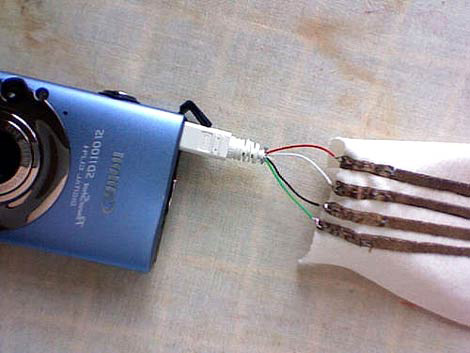
Cut the cable of the USB cable
Cut both ends of the cable, leaving a length of about 2 - 3 cm (add a little if the fear is broken).
After that, peel off the plastic cover on this piece. Make a small knot at the end of the string and attach them together to form a closed circle.

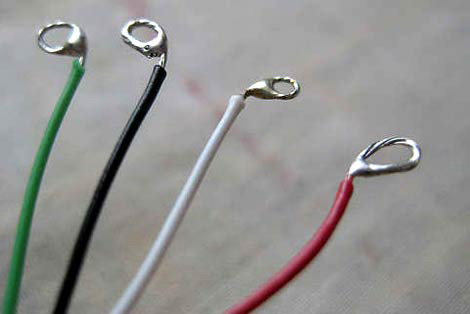
Are electrical conductors on the fabric
Is pressed into a piece of elastic conductive cloth. Cut this string with a width of about 5 mm, 4 or 5 times longer than the width.
Put the elastic cloth often on the cushion and then flatten it. Then, the aforementioned section of electrical conductive cloth on this cloth, place the conductive cloth segments parallel 5 mm apart (note the length of the equivalent).
The resistor for this strip is 5 mm wide and 30 cm wide at about 60 olm. You can halve the resistance value if you double the width (1 cm)
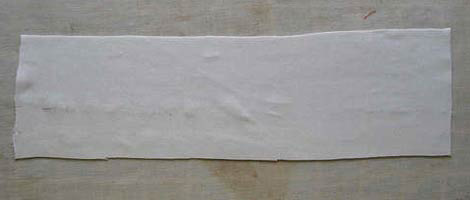
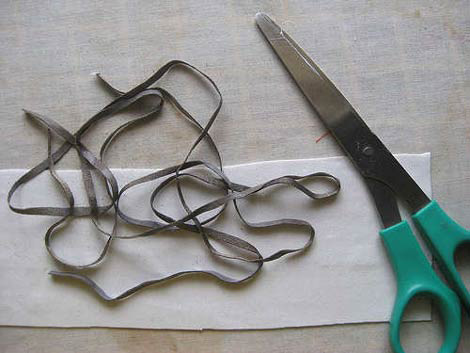
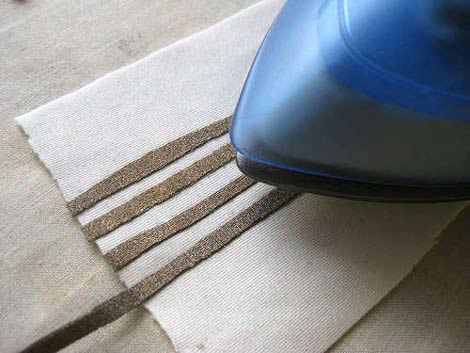
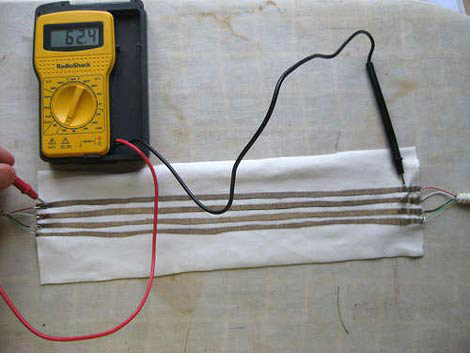
Stitch the fabric
Use electric guides to pierce the needle to sew (note to indicate double). You have to be strangled and you have pressed the top of the USB cord into the conductive cloth section. On the first side, the color of the conductor is not important, but on the second side, you must connect the right color (blue with green, red with red .) depending on the cord in the USB cable.
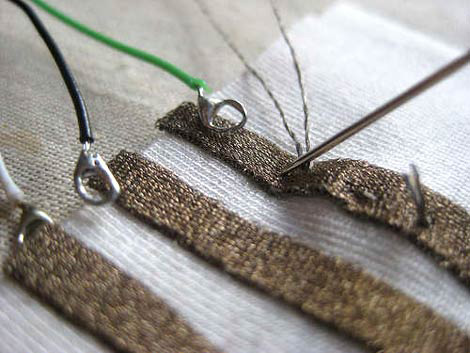

Insulated
After you have finished connecting the conductive components, you will have to insulate this piece. There are many solutions but it is possible by folding the regular piece of rough cloth that surrounds them. You will have to use a thin layer of glue to cover the wires, stitches and wait for them to dry naturally (about 1 day).
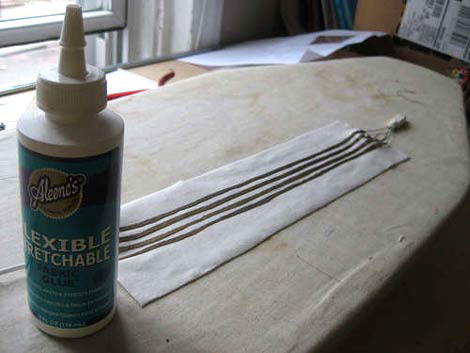
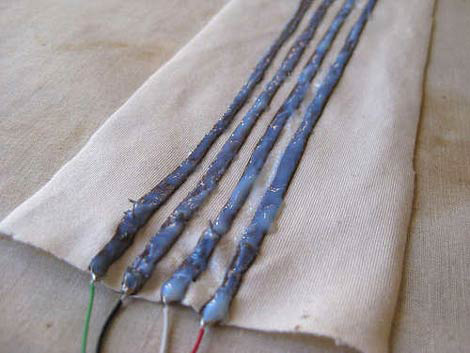
Use chrome powder
The next day, you will see this insulation layer is still quite sticky. Spray some childish chalk on it, shake it evenly and blow the chalk without sticking it.
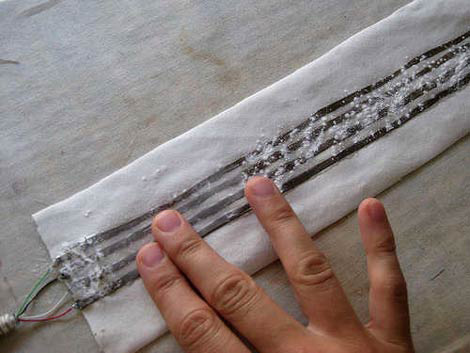
Now you can test the resistor and if the above procedure works well, this resistor will not change.
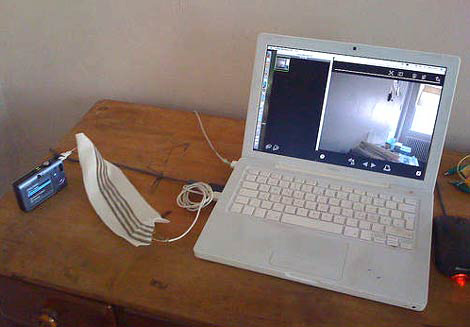
When everything is isolated, you can plug in the USB to check, such as a camera with a laptop.
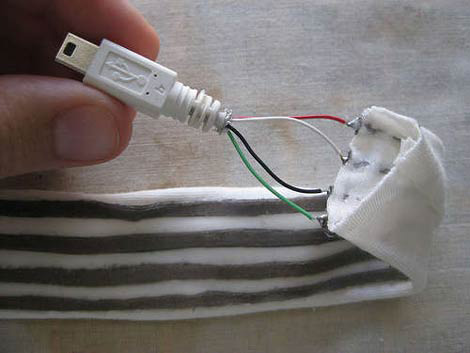
If you like, you can sew the rough cloth around the conductive fibers to look better.
You should read it
- Fix the problem of 'dead' Internet connection
- Inventing a smart fabric that can be wirelessly charged and washed as usual
- How to set up preferred WiFi connection mode on Mac
- Tips to speed up the Internet, connect to the network faster
- How to Replace RV Ceiling Fabric
- How to check if your VPN connection is actually encrypted
- 7 steps to overcome when losing Internet connection on PC
- [Tips] Some tips to speed up the most effective WiFi connection
May be interested
- World fashion modeling software
 programs such as accumark, kaledo 3d trend ... will help professional or amateur designers easily create new fads with reasonable calculations to save fabrics when sewing.
programs such as accumark, kaledo 3d trend ... will help professional or amateur designers easily create new fads with reasonable calculations to save fabrics when sewing. - How to fix errors Your connection is not a private connection
 the error 'your connection is not private' or english is 'your connection is not private'. this is a fairly common mistake and we often encounter when visiting any website. this article of tipsmake.com will guide
the error 'your connection is not private' or english is 'your connection is not private'. this is a fairly common mistake and we often encounter when visiting any website. this article of tipsmake.com will guide - How to arrange network connection on Windows 10
 windows 10 automatically arranges network connections based on parameters. however, we can also change the priority of network connection according to user needs.
windows 10 automatically arranges network connections based on parameters. however, we can also change the priority of network connection according to user needs. - Configure the VPN network connection in Windows XP
 if you want to create a vpn connection, you will have to use encryption to ensure that no one can access and prevent data from being lost while being transported over the internet. windows xp provides a level of security by using point-to-point tunneling (pptp) or layer two tunneling (l2tp) protocol.
if you want to create a vpn connection, you will have to use encryption to ensure that no one can access and prevent data from being lost while being transported over the internet. windows xp provides a level of security by using point-to-point tunneling (pptp) or layer two tunneling (l2tp) protocol. - AI-powered bookmarking tools help make web browsing more efficient
 a new crop of ai-powered apps could change all that. apps like otio and fabric make it easier to save links and files for later use, so you can read, share, and create projects with them.
a new crop of ai-powered apps could change all that. apps like otio and fabric make it easier to save links and files for later use, so you can read, share, and create projects with them. - Does a VPN slow down your Internet connection?
 a vpn is a virtual private network, virtual private network, which is a networking technology that helps to create a secure network connection when participating in a public network such as the internet or a private network owned by a service provider.
a vpn is a virtual private network, virtual private network, which is a networking technology that helps to create a secure network connection when participating in a public network such as the internet or a private network owned by a service provider. - Optimize your dial-up connection: Simple but effective
 do not be discouraged if you are using a dial-up connection. this connection works not so badly and you can basically get better performance from that connection than you still think. most dial-up users are still unaware that there are many ways to speed up their connection. you won't be able to reach the speed of broadband but you can get 10% to 20% faster execution with just a little cost or even a penny.
do not be discouraged if you are using a dial-up connection. this connection works not so badly and you can basically get better performance from that connection than you still think. most dial-up users are still unaware that there are many ways to speed up their connection. you won't be able to reach the speed of broadband but you can get 10% to 20% faster execution with just a little cost or even a penny. - How to Make a Mask Using the Olsen Mask Pattern
 this article will cover how to create a fabric mask using the olson mask pattern that has a pocket for a filter and an additional one for a wire. this is designed to help prevent you from spreading a virus. although it will not prevent you...
this article will cover how to create a fabric mask using the olson mask pattern that has a pocket for a filter and an additional one for a wire. this is designed to help prevent you from spreading a virus. although it will not prevent you... - Create a Site-to-site VPN on ISA 2006 (Part 6)
 in the first five years of a series of how to create a site-to-site vpn between the main office isa firewall and the branch office, we have focused on issues related to creating and managing the site-to-vpn vpn connection itself. site. now, when the details of site-to-site vpn connection are available
in the first five years of a series of how to create a site-to-site vpn between the main office isa firewall and the branch office, we have focused on issues related to creating and managing the site-to-vpn vpn connection itself. site. now, when the details of site-to-site vpn connection are available - Fix the error that cannot delete the VPN connection
 either way, sometimes certain vpn events can interfere with your ability to enjoy this type of service. for example, you might discover that you can't remove the vpn connection from your pc.
either way, sometimes certain vpn events can interfere with your ability to enjoy this type of service. for example, you might discover that you can't remove the vpn connection from your pc.










 'Magic' behind the touch screen
'Magic' behind the touch screen 5 details 'ungainly' in Windows 7
5 details 'ungainly' in Windows 7 Web 2.0 applications will be twice as fast on Firefox 3.1
Web 2.0 applications will be twice as fast on Firefox 3.1 The first logo of famous technology firms
The first logo of famous technology firms The search engine and the race
The search engine and the race Consider about VMware Server 2.0 RC1
Consider about VMware Server 2.0 RC1